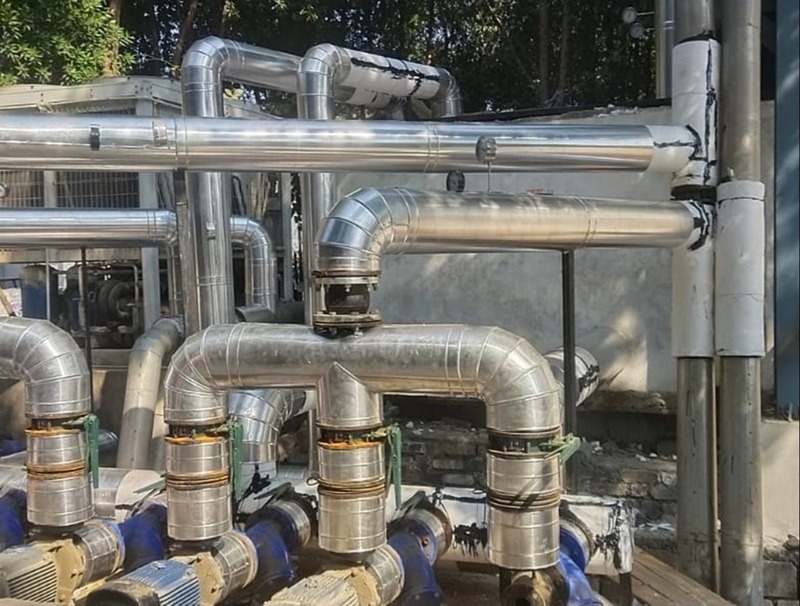Introduction
Industrial Water Cooling Units are specialized systems designed to cool industrial equipment, processes, or machinery by using water as a medium to absorb and dissipate heat. These units are typically essential in industries where large amounts of heat are generated during manufacturing, processing, or operation of equipment such as motors, generators, and industrial machinery. They help in maintaining optimal operating temperatures, reducing wear and tear on machinery, and improving overall efficiency.
Types of Industrial Water Cooling Units:
Air-Cooled Water Chillers:
- Description: These units use air to cool the water that circulates through the system. They are often used in industries where water is required for cooling but the water source is limited or not available.
- Applications: Ideal for applications that require medium to low cooling capacities and in areas where water conservation is important.
- Advantages:
- Lower water usage.
- Can be used in locations where water availability is scarce.
- Generally easier to maintain due to fewer components.
- Limitations:
- Less efficient than water-cooled systems in very large-scale applications.
- Can be noisy due to the use of fans.
Water-Cooled Chillers:
- Description: These units use water to cool a refrigerant, which in turn cools the process water. The heat from the refrigerant is transferred to the water, which is then cooled in a cooling tower or other cooling medium.
- Applications: Common in large-scale industrial settings like power plants, chemical plants, and large manufacturing facilities.
- Advantages:
- More energy-efficient compared to air-cooled chillers.
- Better suited for high-capacity cooling applications.
- Limitations:
- Requires access to a reliable water source for cooling.
- Higher maintenance and water treatment requirements to prevent scaling and corrosion.
Cooling Towers:
- Description: Cooling towers are large-scale systems that reject heat from industrial water systems. They use evaporative cooling, where a portion of the water evaporates, carrying away heat and lowering the temperature of the remaining water.
- Applications: Widely used in industries such as power generation, petrochemical, and manufacturing.
- Advantages:
- High efficiency in rejecting large amounts of heat.
- Cost-effective for large-scale cooling operations.
- Can be used in conjunction with chillers or other cooling units to increase overall system efficiency.
- Limitations:
- Require large amounts of water.
- Maintenance is necessary to prevent biological growth and scale buildup.
- Environmental concerns due to water discharge and evaporation.
Portable Water-Cooled Units:
- Description: These are compact, portable units designed for temporary or smaller-scale cooling needs. They are used for cooling machinery or processes in situations where a permanent installation is not feasible.
- Applications: Often used in construction sites, events, temporary manufacturing facilities, or when there is a sudden need for additional cooling.
- Advantages:
- Flexible and easy to deploy.
- Suitable for temporary or emergency cooling.
- Limitations:
- Lower cooling capacity compared to permanent systems.
- Typically not designed for continuous, large-scale operations.
Chilled Water Systems (Centralized Systems):
- Description: In a chilled water system, large chillers are used to cool a central water loop that is then circulated throughout the facility or complex. The chilled water is directed to air handling units or heat exchangers that cool individual pieces of equipment or entire processes.
- Applications: Used in large-scale industrial facilities like refineries, HVAC systems in commercial buildings, and data centers.
- Advantages:
- Can handle very large-scale cooling operations.
- Centralized system reduces operational costs and allows for better temperature control.
- Limitations:
- Initial installation costs are high.
- Maintenance of large systems can be complex.
Key Features of Industrial Water Cooling Units:
- Cooling Capacity: Water cooling units are available in various capacities, depending on the scale of the operation. The capacity is often measured in tons of cooling (i.e., the amount of heat the unit can remove in one hour).
- Energy Efficiency: Many modern water cooling systems incorporate energy-efficient components, such as variable-speed drives for pumps and fans, to reduce energy consumption.
- Environmental Control: Newer units are designed with better environmental control features, including water treatment systems to reduce corrosion, scaling, and biological growth in the cooling water.
- Automation and Monitoring: Many industrial water cooling units come with automated control systems that monitor parameters like temperature, pressure, and flow rate. These systems can be integrated with industrial control systems for improved efficiency.
- Maintenance Requirements: Regular maintenance, including cleaning, inspecting, and replacing parts like filters, fans, and cooling towers, is essential for maintaining system efficiency and avoiding downtime.
Applications of Industrial Water Cooling Units:
- Power Generation: Cooling turbines, condensers, and other equipment in power plants.
- HVAC: Industrial air conditioning systems that provide cooling to large buildings or complexes.
- Chemical and Pharmaceutical Manufacturing: Cooling reactors, distillation units, and other equipment in chemical processing.
- Metal Processing: Cooling molten metal, welding equipment, and industrial furnaces.
- Data Centers: Keeping servers and IT equipment within optimal temperature ranges.
- Plastic and Rubber Industries: Cooling molds, extrusion systems, and machinery during production.
Conclusion
Industrial Water Cooling Units are crucial for maintaining operational efficiency and prolonging the lifespan of equipment in various industries. The choice between different types of water cooling systems depends on factors such as the scale of operation, available water resources, and specific cooling requirements. Selecting the right unit for a particular application can lead to significant operational cost savings, energy efficiency, and reduced environmental impact.

